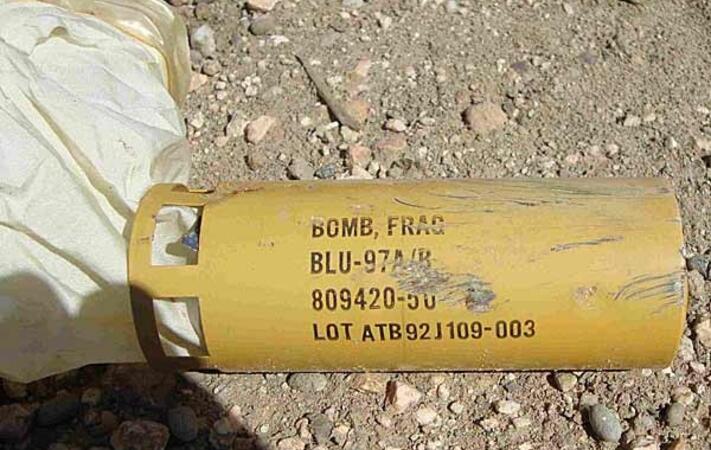According to a report published by Human Rights Watch on October 23, U.S. cluster bomb remnants from a 2009 attack have continued to claim civilian lives in Yemen, most recently in January 2012. The attack on al-Majalah in Yemen's southern Abyan governorate on December 17, 2009 is believed to be the last publicly recorded U.S. use of cluster munitions.
In June 2010, Amnesty International published research including photographs showing the remnants of a U.S. Navy Tomahawk TLAM-D cruise missile and BLU-97 submunitions used to attack an alleged al-Qaeda training camp at al-Majalah. According to Human Rights Watch, as many as many as five TLAM-D cruise missiles--each containing 166 BLU-97 submunitions or bomblets--struck the hamlet, killing 14 alleged Al Qaeda fighters as well as 41 civilians in a Bedouin camp, all from two extended families, including 9 women and 21 children.
Subsequent investigation by Human Rights Watch shows that in the period after, the distinctive yellow BLU-97 bomblets killed at least 4 more civilians and wounded 13 others. Four days after the strike, three more people were killed and nine others injured by unexploded bomblets at al-Majalah during a massive protest rally. At least two people died on the scene, prompting people there to call a group that had driven away with some of the bomblets to warn them they could explode. The people in the car removed the bomblets, which they had taken as evidence, and in doing so detonated them, killing one other person.
On January 24, 2012, a young boy brought a bomblet home as he returned for lunch. It subsequently exploded, killing his father and injuring him and two siblings.
The Yemeni government accepted the recommendations of a 2010 report of a parliamentary investigation into the incident, which called for it to “hold accountable those found guilty” of the attack, requested that authorities compensate victims and pay their medical bills in a “swift manner,” remove cluster munition remnants from the site, and develop and bring basic services to the area.
In October 2013, Human Rights Watch found that despite accepting the report’s findings, the Yemeni government failed to implement any of these recommendations. The families have not received any compensation for the deaths or injuries, including four children orphaned in the attack. Al-Majalah's inhabitants reportedly rebuffed government offers to clear the cluster munition remnants, saying they feared the authorities would do a poor job and sought international assistance to clear the site.
The U.S. has never publicly commented on the incident, but in December 2010, Wikileaks released a U.S. Department of State cable dated 21 December 2009 that acknowledged the U.S. role in the 17 December strike. The cable said that Yemeni government officials “continue to publicly maintain that the operation was conducted entirely by its forces, acknowledging U.S. support strictly in terms of intelligence sharing. Deputy Prime Minister Rashad al-Alimi told the Ambassador on December 20 that any evidence of greater U.S. involvement such as fragments of U.S. munitions found at the sites - could be explained away as equipment purchased from the U.S.”
For more information, see:
- Human Rights Watch, "Between a Drone and Al Qaeda" (Oct. 23, 2013)
